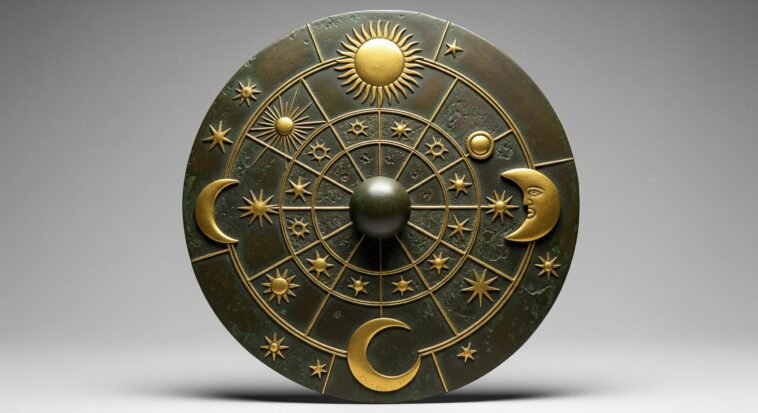
The Bronze Age (3300–1200 BCE) was humanity’s big glow-up—metal tools, growing cities, and writing made their debut.
Thanks to some epic archaeological finds, we get a sneak peek into how people lived back then.
This article breaks down ten of the coolest Bronze Age discoveries—basically ancient Netflix, but with more dirt and zero buffering.
1. Nebra Sky Disc (Germany)
Imagine finding a Bronze Age version of a smartphone screen—but instead of apps, it shows the night sky.
That’s basically what the Nebra Sky Disc is.
Discovered in 1999 near Nebra, Germany, this bronze circle—about the size of a pizza—dates back to around 1600 BCE.
It’s covered with gold symbols representing the sun, moon, stars, and even the Pleiades star cluster.
Why’s it so cool? Because it’s the oldest known “astronomy chart” in the world.
These folks weren’t just staring at the stars for fun; they were tracking celestial events with serious smarts, way before telescopes or space travel.
It’s like the original star map, showing Bronze Age Europe had a sky-watching hobby—and they nailed it.
2. Treasure of Villena (Spain)
If Indiana Jones were into European bling, the Treasure of Villena would be his jackpot.
Found in 1963 near Villena, Spain, this treasure trove includes 59 dazzling objects made from gold, silver, iron, and amber—adding up to nearly 10 kilograms of pure ancient swag.
Dating back to between 1300 and 1000 BCE, this collection isn’t just about shiny stuff.
Bowls, bracelets, and fancy bottles reveal the incredible skill and wealth of the society that made them. These people clearly knew their way around a forge and had taste to match.
Basically, it’s a Bronze Age flex showing, “Yeah, we’re rich, crafty, and we know how to party.”

3. Tell el-Ajjul Gold Hoards (Gaza Strip)
Back in the 1930s, archaeologists digging around Tell el-Ajjul in the Gaza Strip stumbled on some seriously shiny treasure: gold jewelry from around 1750 to 1550 BCE.
We’re talking pendants, earrings, and other bling that screams “Middle Bronze Age luxury.”
These pieces don’t just sparkle—they tell a story about a region that was both rich and artsy, with skilled jewelers making jewelry that could easily compete with anything in today’s fancy stores.
Basically, the Canaanites were rocking their version of red carpet glam long before Hollywood was even a thing.
4. Dendra Panoply (Greece)
Imagine finding a full suit of armor from 15th-century BCE Greece that looks like it could’ve been worn by a Bronze Age superhero.
That’s exactly what happened near the village of Dendra in 1960.
This Mycenaean bronze armor set—helmet, chestplate, and leg guards—is one of the oldest full-body armors we’ve ever seen.
For a while, people thought it was just ceremonial bling (like armor you’d wear to a fancy party, not a fight).
But experimental tests proved it actually worked in battle.
So, the guy who wore this wasn’t just posing for ancient Instagram; he was ready to throw down.
Talk about mixing style and substance!
5. Must Farm Settlement (England)
Think of Must Farm as the Bronze Age’s version of Pompeii—only this time, it’s a village on stilts over a river in Cambridgeshire, England, around 850 BCE.
The settlement got wiped out by a fire, and because everything fell into the wet river below, it’s insanely well-preserved.
Archaeologists found everything from pots and tools to bits of cloth and even ancient snacks (yeah, they found food remains!).
It’s like someone hit the pause button on Bronze Age daily life, giving us an epic backstage pass to what people actually did every day—cooking, crafting, and chilling by the river.

6. Egtved Girl (Denmark)
Back in 1921, archaeologists found the remains of a young woman buried around 1370 BCE in Denmark—nicknamed the Egtved Girl.
She was laid to rest inside a hollowed-out oak trunk, rocking a wool skirt and belt, plus some fancy grave goods like a bronze bowl and a birch-bark container.
Here’s the twist: isotope tests revealed she wasn’t just a local—she traveled a lot, kind of like a Bronze Age globetrotter.
This tells us that even back then, people were moving around, trading, and connecting with different groups, way before the age of Instagram influencers and world tours.
7. Tanum Rock Carvings (Sweden)
If ancient graffiti had a museum-worthy hotspot, it’d be the Tanum region in western Sweden.
Between 1700 and 500 BCE, Bronze Age folks here decided to leave their mark—literally—by carving scenes of their daily grind, rituals, and some mysterious symbols into rocks.
These petroglyphs are like a prehistoric Instagram feed showing what mattered to them: hunting, celebrations, and maybe a bit of early storytelling.
Because of their cultural richness, the carvings earned a VIP pass as a UNESCO World Heritage Site.
So next time you doodle on your notebook, just remember—somewhere in Sweden, people made rock art that’s lasted thousands of years and still tells their story.
8. Great Orme Copper Mines (Wales)
Now, picture this: a massive underground Bronze Age factory where people were digging deep for copper over 4,000 years ago.
Welcome to the Great Orme mines in North Wales—one of the largest prehistoric mining operations on the planet.
These mines show how serious Bronze Age societies were about getting their hands on copper, the OG ingredient for all those shiny tools and weapons.
They weren’t just scraping the surface; they engineered tunnels and shafts like pros, proving that Bronze Age folks had some serious tech skills—way before the industrial revolution made mining cool.
9. Akrotiri (Greece)
Imagine a whole ancient city frozen in time by a volcanic eruption—welcome to Akrotiri on Santorini, Greece’s Bronze Age “Minoan Pompeii.”
Around 1600 BCE, volcanic ash buried this settlement, preserving its multi-story buildings, stunning frescoes, and everyday objects like a time capsule on steroids.
Akrotiri wasn’t just any town; it had smart urban planning that would make modern architects jealous, with organized streets and drainage systems.
Plus, the art? Think vibrant wall paintings that look like they belong in a high-end gallery.
This place gives us a front-row seat to how advanced and artsy the Aegean world was back then—way before Instagram aesthetics were a thing.

10. Phourni Cemetery (Crete)
Now, let’s talk about Phourni Cemetery near Archanes, Crete.
This burial site was in use for over a thousand years, from around 2000 to 700 BCE, and it’s packed with tombs full of cool grave goods—seal stones, jewelry bling, pottery—you name it.
These finds offer a rare peek into Minoan burial customs and social vibes.
Who got what in the afterlife? How did status show up in their funerals? Phourni helps us decode these ancient social hierarchies and rituals, kind of like piecing together a Bronze Age family drama.
Spoiler: They took their afterlife pretty seriously.
Wrapping It Up: Why These Finds Still Matter
These discoveries show Bronze Age people were way smarter and cooler than you’d guess—think ancient inventors and trendsetters.
Each find is like unlocking a level in humanity’s biggest game.
Plus, protecting this stuff keeps our epic story alive. Old bling or city ruins, they’re all Bronze Age legends—and honestly, that’s pretty badass.



